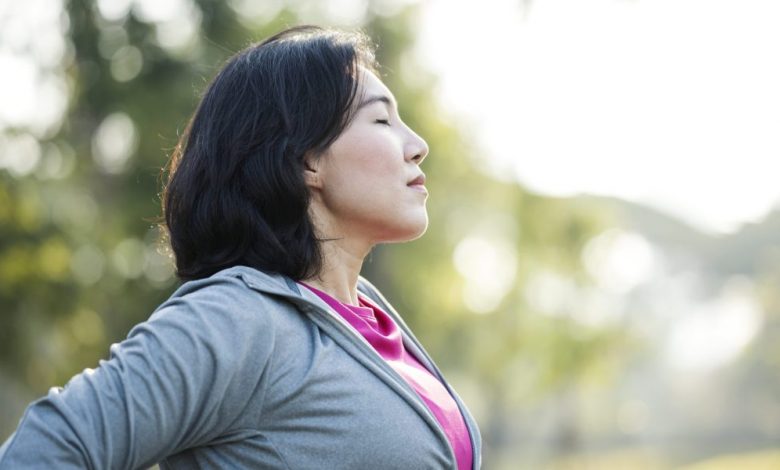Heart rate variability could be the key to improving your body’s response to stress. Here’s how to get started

A few years ago, migraines and anxiety affected Kate’s performance at work, and medication didn’t help. Her neurologist suggested breathing exercises aimed at increasing her heart rate variability, or HRV.
Kate, 38, a financial analyst in Manhattan who requested that her first name be used only for privacy reasons, learned that HRV refers to the time gap between each heartbeat. Although the heart feels like a steadily beating drum, there are tiny changes in the length of these intervals, and people with more variation between each heartbeat tend to have better physical and emotional health.
New technologies are making it easier to measure and maybe increase your HRV, and some of the companies behind them are teaming up.
What is HRV
The time between heartbeats changes due to a balancing act between two branches of the nervous system that control some of the body’s most important activities. The sympathetic branch carries signals that help us respond to stressful challenges; it increases heart rate, sweating, and other automatic “fight-or-flight” responses. The second branch, called the parasympathetic, exerts the opposite force and slows the heartbeat when we need to rest.
Even when you’re not active or resting, these two branches stay engaged with each breath, speeding up your heartbeat on the inhale and slowing it down on the exhale. The faster your heartbeat changes in either direction, the higher your HRV, suggesting that the nervous system is well balanced, able to slightly increase your energy and heart rate when needed – for example when running 5km – and just as good at helping you switch off right after a race or other physical or emotional stressor.
Think of HRV like a tennis player balancing the weight from one foot to the other before returning the serve. A high HRV suggests you can move gracefully in either direction to deal with whatever life throws at you.
As long as your HRV isn’t also high. “A person’s HRV is very individual,” says Tim Roberts, vice president of science and innovation at Therabody, which conducts voice-guided breathing sessions to increase HRV. “You don’t want the trend to be too far outside of your normal range.”
Lower HRV has been linked to shorter lifespan, obesity, cardiovascular disease, inflammation, mental health issues, and viruses.
Jessilyn Dunn, assistant professor of biomedical engineering at Duke, found that HRV can drop when people get sick with Covid-19, the flu, or a common cold. “There’s a combination of changes in HRV, resting heart rate, exercise, and sleep that combine to create an infection signature,” says Dunn.
How lifestyle affects HRV
Roberts emphasizes that HRV is “just one factor” in health monitoring, along with regular blood tests and physical exams. But it’s an important one, he says — and the good news is we can control a variety of lifestyle factors that affect HRV. It’s also easy to measure across devices and apps.
In September, Therabody made its HRV breathing sessions called TheraMind available on the Oura app. Oura ring wearers can see how their HRV changes after using these sessions and how they are adjusting habits like sleep and exercise. Oura Ring sensors are best for tracking HRV overnight, while waving your hand while awake could skew the reading. Some prefer Polar chest straps for daily measurements that don’t require standing still.
The best way to determine your personal HRV range is to measure it as part of your daily routine at the same time of day for a few months. Because so many factors can affect HRV on any given day, you should write down your daily number along with any issues that might skew the HRV high or low, such as: B. a stressful day at work or a cold. Then you can look back several months to determine your baseline HRV, or what is normal for you.
However, your HRV isn’t necessarily set in stone; Research points to several “interventions that enhance the body’s natural recovery responses,” says Roberts.
For example, regular exercise “really helps your body maintain homeostasis,” he explains, and may increase HRV. Diet is another factor, with studies showing that following a diet high in fruits and vegetables or intermittent fasting increases HRV in many individuals. This could be because these diets reduce inflammation more than other eating plans; Severe inflammation can kick the sympathetic nervous system into overdrive and reduce HRV. And adequate hydration throughout the day could increase HRV—that is, water. Robert’s own HRV drops after a few beers, a finding observed in several studies.
HRV is also affected by increases in emotional well-being. Researchers see that HRV increases when people focus on pleasant memories. Psychologist Leah Lagos enjoys taking her kids to school so much that her HRV stays high for the rest of the day. After observing this effect in her Oura app, she takes them with her more often.
Despite these associations, researchers are still unsure of direct causality. Many factors, such as reducing stress and fasting, can improve sleep to increase HRV. Therabody now markets several products, including its Theragun massager, to increase HRV through improved sleep.
How breathing affects HRV
Polar’s sensor, when used with apps like Elite HRV, shows HRV in real time and shows how certain breathing practices affect it.
Paul Lehrer, a Rutgers psychologist, has spent three decades studying HRV biofeedback and its benefits. The first step in Teacher’s protocol is to find out something called your resonant frequency: the exact rate of breathing that’s synchronized with your heart rate.
To find your resonant frequency, lengthen each inhalation and exhalation so that the entire breath takes about 11 seconds. The inhale and exhale ratio is different for each person, but it will be about four seconds long, seven seconds long. Breathing this way will increase the gap between your fastest heart rate when you take a deep breath and your slowest heart rate as it drops during the long exhale. By looking at the Elite HRV app, you will learn the pace of inhalation and exhalation that will deliver your highest HRV.
“I can change your HRV within minutes of a workout,” says Lehrer. Then “something very special happens”. He has found that breathing at the resonant frequency for 20 minutes, twice a day, over a ten week period is associated with major benefits such as: B. Reduced depression, drug cravings and anxiety.
And in Kate’s case, fewer migraines. She likes HRV biofeedback better than meditation, which made her too gentle. “I’m Type A and naturally anxious, but it helps me succeed,” says Kate. “Now I can use that fear and control it to my advantage instead of letting it control me.”
The benefits can extend to cognitive performance, studies show, including better emotional regulation. The heart-brain connection is hardwired through the vagus nerve, and by controlling the heart through the work of breathing, “you’re changing the body to change the brain,” says Lagos. She has guided professional athletes and business leaders through sessions to improve HRV, post concussion syndrome, recovery and performance.
While the Polar bracelet retails for $90, a more expensive sensor from HeartMath promises more. Called Inner Balance, it clips to your earlobe, and its software encourages you to breathe at resonant frequency while enjoying pleasant thoughts, images, and music. With 15-minute sessions a day, you can practice moving into a state of quiet arousal, according to 25 years of HeartMath research. “Relaxation is wonderful in itself, but it’s not a high-performance state,” says Deborah Rozman, psychologist and founding executive director of HeartMath.
Lagos agrees that HRV biofeedback can help users achieve that peaceful, focused state, also known as flow, with practice. Her 10 week program is available through Elite HRV and is detailed in her book.
“HRV is definitely trainable,” says Dunn, the Duke researcher. However, she warns that genetics, age, and biological sex can limit the range (women and the elderly tend to have lower HRV), and wonders if the cognitive benefits of HRV biofeedback might come simply from having “more oxygenated blood.” circulates to your brain” while inhaling deeply, just like other breathing exercises.
And how many people have time for this training? “It’s not really practical for our daily lives,” says Dunn.
However, access has improved in recent years. Cell phone cameras have proven to be surprisingly accurate when measuring HRV – there is no need to buy a separate sensor. Meanwhile, Dunn is researching how HRV might one day be adopted by healthcare. “HRV is on the low end of what clinicians think is worth studying,” says Dunn. “Their feasibility isn’t entirely clear at this point, but as we learn more about it, that’s likely to change.”



